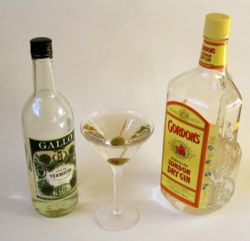Martini: Difference between revisions
imported>Hayford Peirce (added image -- I think they actually look better than they taste....) |
imported>Yi Zhe Wu (assigning workgroups---We need an alcohol workgroup, but we dont have one yet) |
||
| Line 10: | Line 10: | ||
==Sources== | ==Sources== | ||
''The American Heritage Cookbook and Illustrated History of American Eating & Drinking'', American Heritage Publishing Co., New York, 1964, Vol. 2, page 620 | ''The American Heritage Cookbook and Illustrated History of American Eating & Drinking'', American Heritage Publishing Co., New York, 1964, Vol. 2, page 620 | ||
[[category:CZ Live]] | |||
[[category:Food Science Workgroup]] | |||
Revision as of 18:37, 14 June 2007
A martini is a popular cocktail, particularly in the Anglo-Saxon world, that is made with gin and dry white vermouth and drunk very cold from a chilled glass. Since its first appearance in the 19th century, its popularity has varied dramatically over the decades; at the moment it is apparently enjoying a resurgence. Although numerous variations of the basic cocktail exist, purists insist that both gin and vermouth be used; vodka has replaced gin for many people and the quest for an ever "drier" martini has also led to the complete absence of vermouth in many variations. "Crisp" and "astringent" are words frequently used to describe its taste, but connoisseurs of martinis debate the proper ratio of gin to vermouth; it is generally accepted, however, that 5 or 6 parts of gin to 1 part of vermouth is the classic mix. Connoisseurs also argue the merits of how to chill the drink during its mixing: whether by stirring ice cubes in the liquid or by shaking the mixture in a cocktail shaker along with the ice. Both claim that their method does less to "bruise" and/or dilute the finished drink. A martini is traditionally strained into a chilled glass, then garnished with either an olive or a twist of lemon, although some people drink it "on the rocks", with ice in the glass.
Another never-ending debate concerns the invention of the martini, by whom and where. There are dozens of possible candidates. One of the more famous ones is Jerry Thomas, author of The Bon-Vivant's Companion. There, he claims that he first made it while tending bar at the Occidental Hotel in San Francisco between 1860 and 1862 and originally called it the Martinez, after a town not far from San Francisco.[1]
References
- ↑ The American Heritage Cookbook and Illustrated History of American Eating & Drinking, American Heritage Publishing Co., New York, 1964, Vol. 2, page 620
Sources
The American Heritage Cookbook and Illustrated History of American Eating & Drinking, American Heritage Publishing Co., New York, 1964, Vol. 2, page 620
